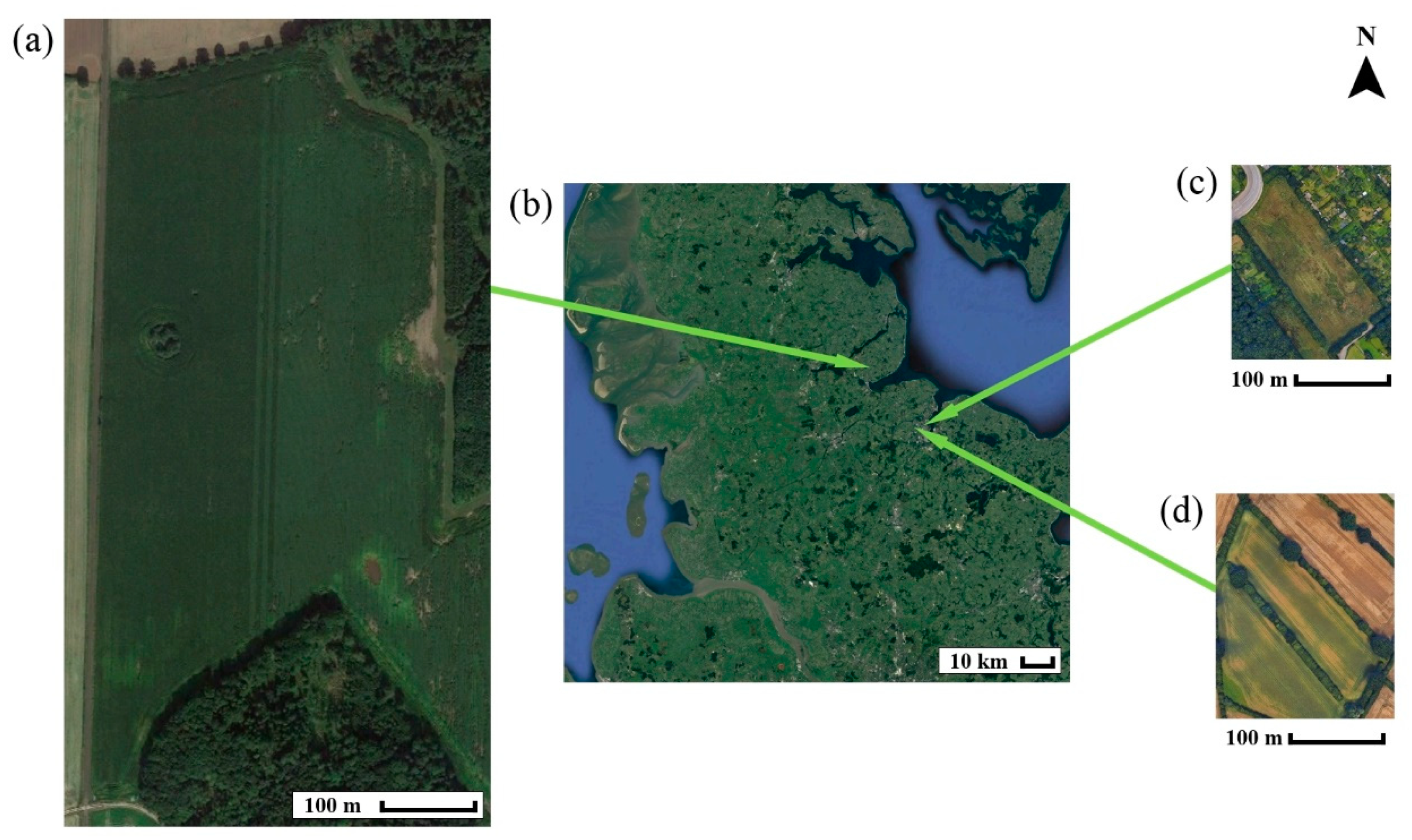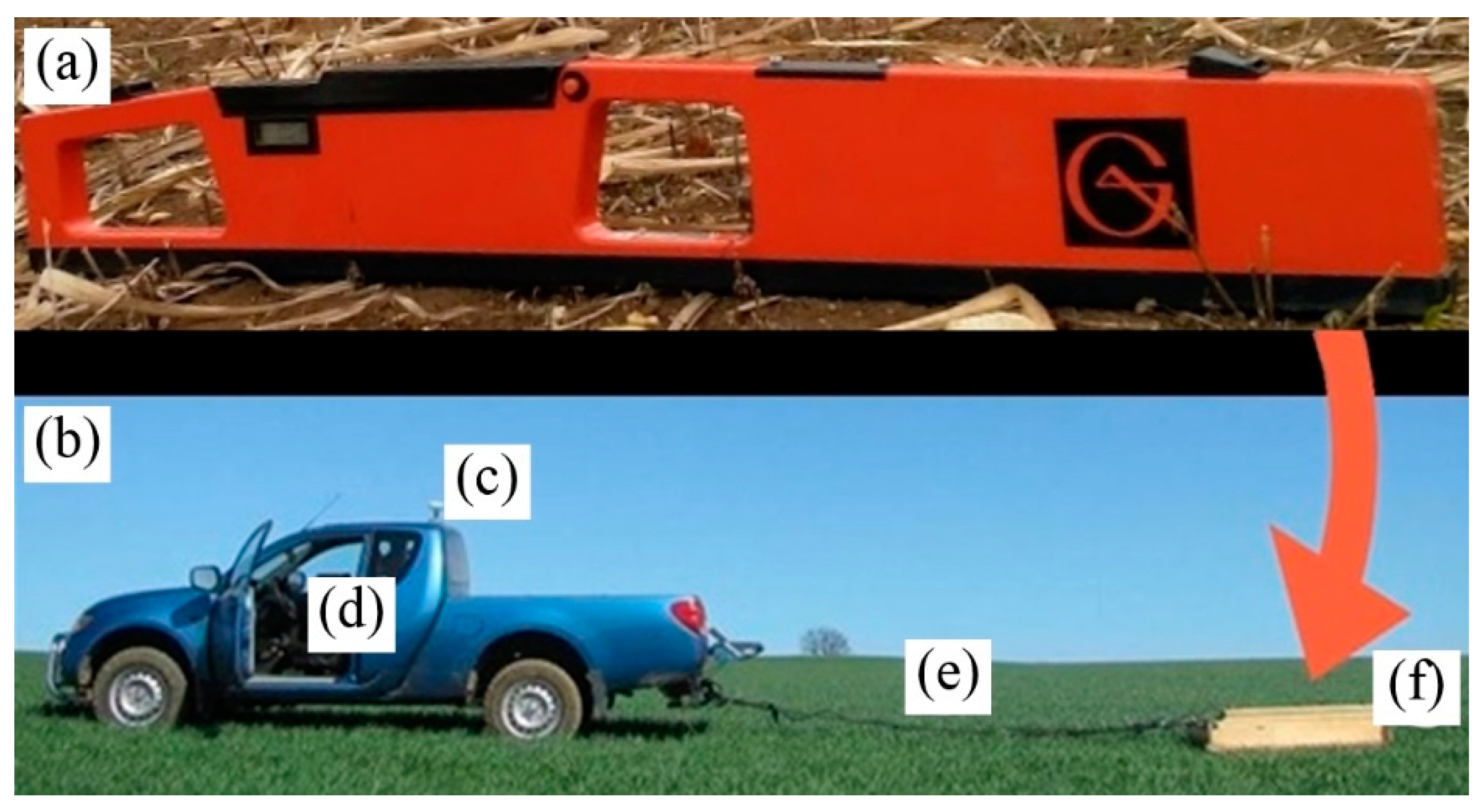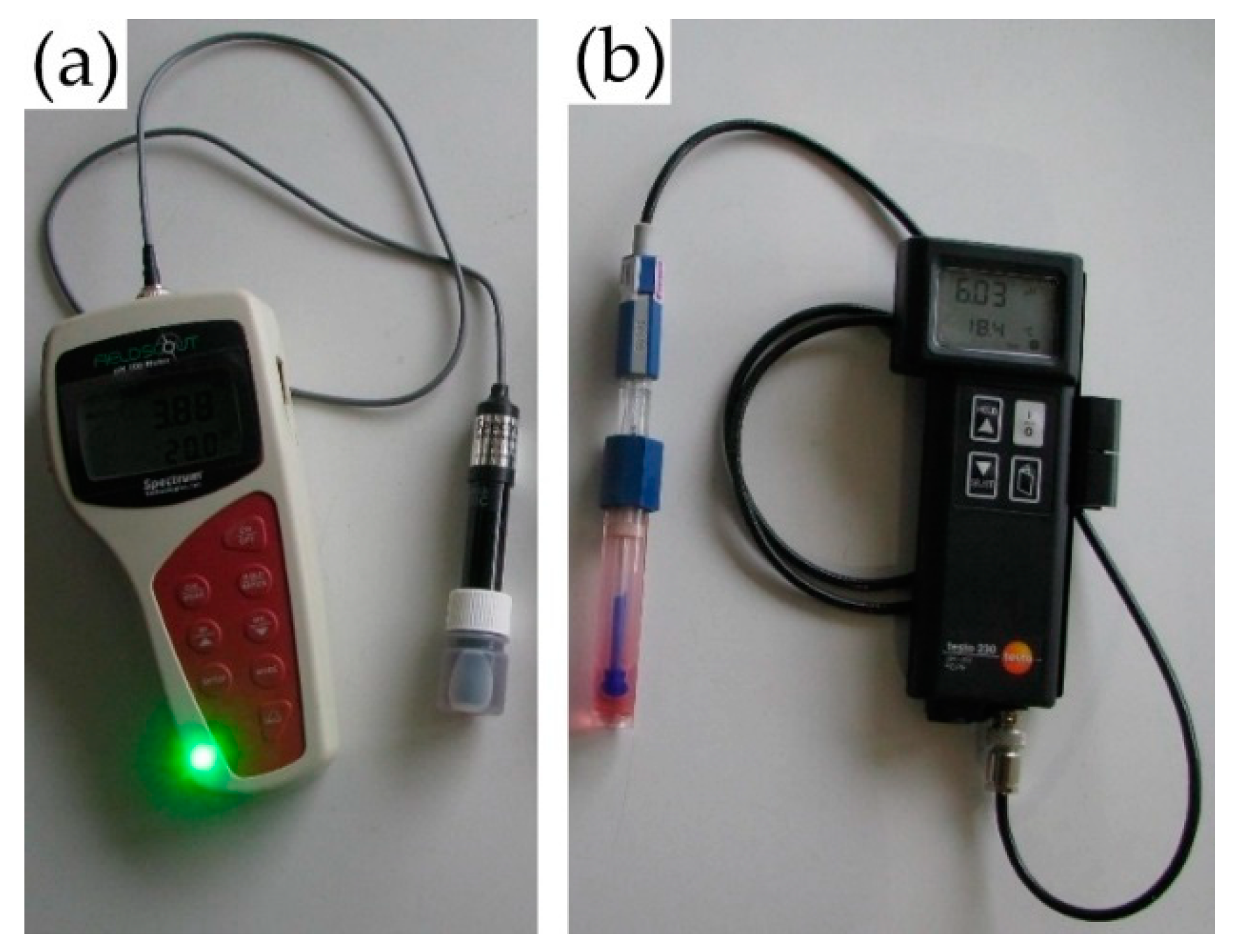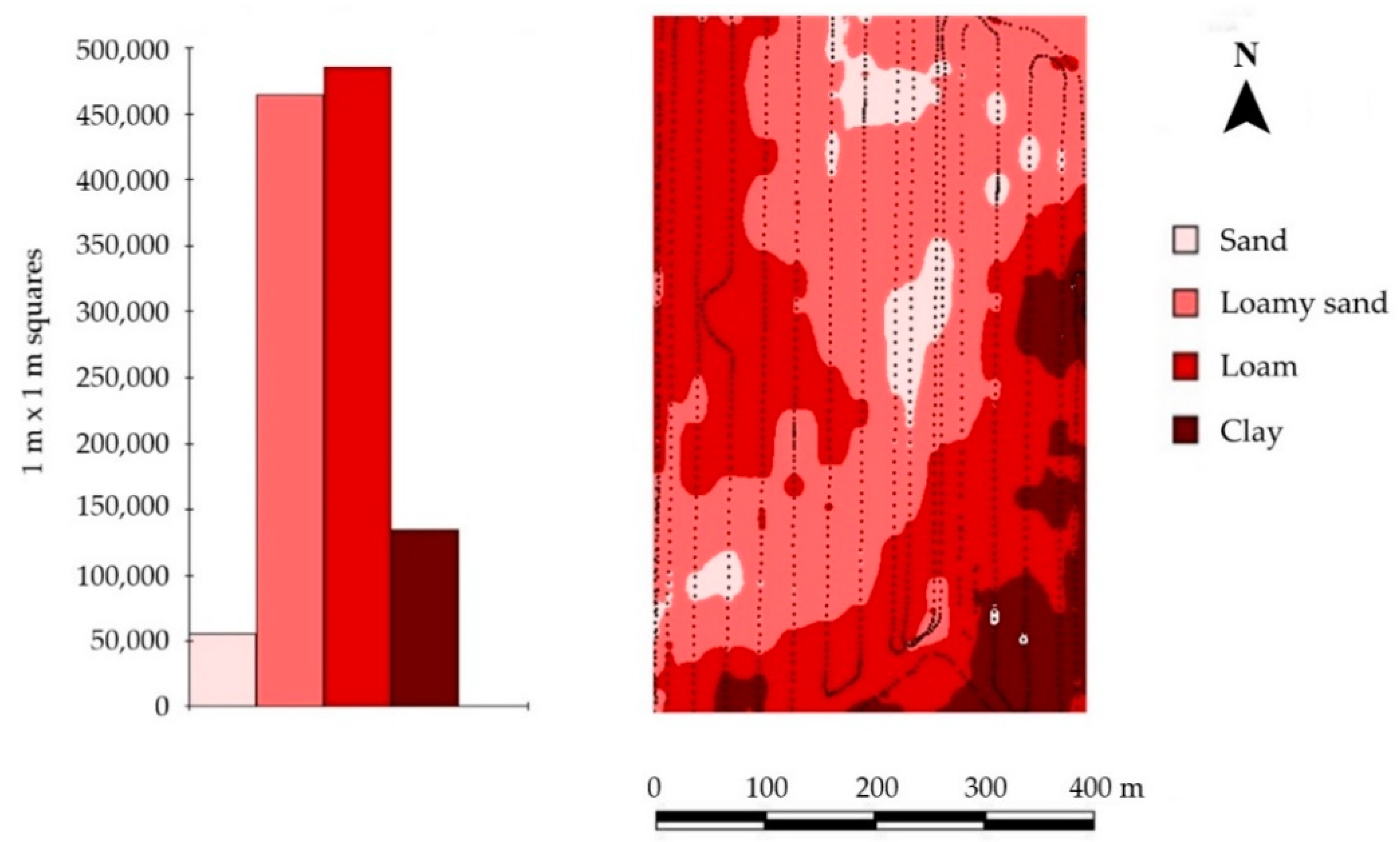Low-Input Estimation of Site-Specific Lime Demand Based on Apparent Soil Electrical Conductivity and In Situ Determined Topsoil pH
Abstract
1. Introduction
2. Materials and Methods
2.1. Description of Experimental Sites
2.2. The Determination of Soil Apparent Electrical Conductivity
2.3. In Situ and Ex Situ Determination of Topsoil pH
2.3.1. Soil Sampling and In Situ Determination of Topsoil pH
2.3.2. Ex-Situ Determination of Topsoil pH
2.4. Statistical Analysis
2.5. Lime Demand Calculation
3. Results & Discussion
3.1. ECa and pH Distribution
3.2. The Correlation Between ECa and Ex Situ Determined pH—Implications for Lime Demand Estimation
3.3. The Correlation Between In-Situ and Ex-Situ Determined Topsoil pH
3.4. Effects of In Situ and Ex Situ Determined Topsoil pH on the Estimated Lime Demand Distribution
3.5. Consequences for Practical Implementation and Future Research Directions
4. Conclusions
Supplementary Materials
Author Contributions
Funding
Acknowledgments
Conflicts of Interest
Appendix A



References
- Van Breemen, N.; Mulder, J.; Driscoll, C.T. Acidification and alkalinization of soils. Plant Soil 1983, 75, 283–308. [Google Scholar] [CrossRef]
- Reuss, J.O.; Cosby, B.J.; Wright, R.F. Chemical processes governing soil and water acidification. Nature 1987, 329, 27–32. [Google Scholar] [CrossRef]
- Chai, A.L.; Xie, X.W.; Shi, Y.X.; Li, B.J. Research status of clubroot (Plasmodiophora brassicae) on cruciferous crops in China. Can. J. Plant Pathol. 2014, 36, 142–153. [Google Scholar] [CrossRef]
- Deutscher Landwirtschaftsverlag GmbH Marktpreise Kalkdünger. 2019. Available online: https://markt.agrarheute.com/duengemittel-4/kalkduenger-24 (accessed on 24 October 2019).
- KTBL. Web-Anwendungen. 2019. Available online: https://www.ktbl.de/webanwendungen/ (accessed on 22 July 2019).
- Destatis. Düngemittelversorgung Wirtschaftsjahr 2017/2018; Produzierendes Gewerbe; Statistisches Bundesamt: Wiesbaden, Germany, 2019.
- Sanches, G.M.; Magalhães, P.S.G.; Remacre, A.Z.; Franco, H.C.J. Potential of apparent soil electrical conductivity to describe the soil pH and improve lime application in a clayey soil. Soil Tillage Res. 2018, 175, 217–225. [Google Scholar] [CrossRef]
- Lund, E.D.; Adamchuk, V.I.; Collings, K.L.; Drummond, P.E.; Christy, C.D. Development of soil pH and lime requirement maps using on-the-go soil sensors. 5th Eur. Conf. on Precis. Agr. 2005, 5, 457–464. [Google Scholar]
- Dennerley, C.; Huang, J.; Nielson, R.; Sefton, M.; Triantafilis, J. Identifying soil management zones in a sugarcane field using proximal sensed electromagnetic induction and gamma-ray spectrometry data. Soil Use Manag. 2018, 34, 219–235. [Google Scholar] [CrossRef]
- Hinck, S.; Kolata, H.; Emeis, N.; Mueller, K. Der Nutzen von kleinräumigen Feldbodenkarten im teilflächenspezifischen Pflanzenbau. In Jahrestagung der Deutschen Bodenkundlichen Gesellschaft (Unsere Böden—Unser Leben); Deutschen Bodenkundlichen Gesellschaft: Munich, Germany, 2015. [Google Scholar]
- Sun, Y.; Druecker, H.; Hartung, E.; Hueging, H.; Cheng, Q.; Zeng, Q.; Sheng, W.; Lin, J.; Roller, O.; Paetzold, S.; et al. Map-based investigation of soil physical conditions and crop yield using diverse sensor techniques. Soil Tillage Res. 2011, 112, 149–158. [Google Scholar] [CrossRef]
- Gómez, J.A.; Sobrinho, T.A.; Giráldez, J.V.; Fereres, E. Soil management effects on runoff, erosion and soil properties in an olive grove of Southern Spain. Soil Tillage Res. 2009, 102, 5–13. [Google Scholar] [CrossRef]
- Vogel, S.; Lück, K.; Gebbers, R.; Rühlmann, J.; Scheibe, D.; Kling, C.; Bönecke, E.; Schröter, I.; Philipp, G.; Nagel, A.; et al. Kalkdüngung—Aber bitte präzise. Landwirtsch Ohne Pflug 2019, 8, 48–53. [Google Scholar]
- Lorenz, F.; Armbruster, M.; König, V.; Nätscher, L.; Olfs, H.W. Georeferenzierte Bodenprobenahme auf Landwirtschaftlichen Flächen als Grundlage für eine Teilschlagspezifische Düngung mit Kalk und Grundnährstoffen; Standpunkte des VDLUFA; Verband Deutscher Landwirtschaftlicher Untersuchungs- und Forschungsanstalten e.V.: Speyer, Germany, 2015. [Google Scholar]
- Koganti, T.; Moral, F.J.; Rebollo, F.J.; Huang, J.; Triantafilis, J. Mapping cation exchange capacity using a Veris-3100 instrument and invVERIS modelling software. Sci. Total Environ. 2017, 599, 2156–2165. [Google Scholar] [CrossRef]
- Van Meirvenne, M.; Islam, M.M.; De Smedt, P.; Meerschman, E.; Van De Vijver, E.; Saey, T. Key variables for the identification of soil management classes in the aeolian landscapes of north–west Europe. Geoderma 2013, 199, 99–105. [Google Scholar] [CrossRef]
- Piikki, K.; Söderström, M.; Stenberg, B. Sensor data fusion for topsoil clay mapping. Geoderma 2013, 199, 106–116. [Google Scholar] [CrossRef]
- Vitharana, U.W.A.; Van Meirvenne, M.; Simpson, D.; Cockx, L.; De Baerdemaeker, J. Key soil and topographic properties to delineate potential management classes for precision agriculture in the European loess area. Geoderma 2008, 143, 206–215. [Google Scholar] [CrossRef]
- Carroll, Z.L.; Oliver, M.A. Exploring the spatial relations between soil physical properties and apparent electrical conductivity. Geoderma 2005, 128, 354–374. [Google Scholar] [CrossRef]
- Earl, R.; Taylor, J.C.; Wood, G.A.; Bradley, I.; James, I.T.; Waine, T.; Welsh, J.P.; Godwin, R.J.; Knight, S.M. Soil Factors and their Influence on Within-field Crop Variability, Part I: Field Observation of Soil Variation. Biosyst. Eng. 2003, 84, 425–440. [Google Scholar] [CrossRef]
- Anastasiou, E.; Castrignanò, A.; Arvanitis, K.; Fountas, S. A multi-source data fusion approach to assess spatial-temporal variability and delineate homogeneous zones: A use case in a table grape vineyard in Greece. Sci. Total Environ. 2019, 684, 155–163. [Google Scholar] [CrossRef] [PubMed]
- Lueck, E.; Ruehlmann, J. Resistivity mapping with GEOPHILUS ELECTRICUS—Information about lateral and vertical soil heterogeneity. Geoderma 2013, 199, 2–11. [Google Scholar] [CrossRef]
- Cho, Y.; Sudduth, K.A.; Chung, S.O. Soil physical property estimation from soil strength and apparent electrical conductivity sensor data. Biosyst. Eng. 2016, 152, 68–78. [Google Scholar] [CrossRef]
- Sainju, U.M.; Ghimire, R.; Pradhan, G.P. Nitrogen Fertilization II: Management Practices to Sustain Crop Production and Soil and Environmental Quality. In Nitrogen in Agricultural Systems; IntechOpen: London, UK, 2019. [Google Scholar]
- Schirrmann, M.; Gebbers, R.; Kramer, E.; Seidel, J. Soil pH mapping with an on-the-go sensor. Sensors 2011, 11, 573–598. [Google Scholar] [CrossRef]
- Heil, K.; Schmidhalter, U. The Application of EM38: Determination of Soil Parameters, Selection of Soil Sampling Points and Use in Agriculture and Archaeology. Sensors 2017, 17, 2540. [Google Scholar] [CrossRef]
- Molin, J.P.; Tavares, T.R. Sensor systems for mapping soil fertility attributes: Challenges, advances, and perspectives in brazilian tropical soils. Eng. Agrícola 2019, 39, 126–147. [Google Scholar] [CrossRef]
- Fulton, A.; Schwankl, L.; Lynn, K.; Lampinen, B.; Edstrom, J.; Prichard, T. Using EM and VERIS technology to assess land suitability for orchard and vineyard development. Irrig. Sci. 2011, 29, 497–512. [Google Scholar] [CrossRef]
- Bronson, K.F.; Booker, J.D.; Officer, S.J.; Lascano, R.J.; Maas, S.J.; Searcy, S.W.; Booker, J. Apparent electrical conductivity, soil properties and spatial covariance in the U.S. Southern High Plains. Precis. Agric. 2005, 6, 297–311. [Google Scholar] [CrossRef]
- Heil, K.; Schmidhalter, U. Theory and Guidelines for the Application of the Geophysical Sensor EM38. Sensors 2019, 19, 4293. [Google Scholar] [CrossRef]
- McNeill, J.D. Electromagnetic Terrain Conductivity Measurement at Low Induction Numbers; Geonics Limited: Mississauga, ON, Canada, 1980. [Google Scholar]
- Minasny, B.; McBratney, A.B. Digital soil mapping: A brief history and some lessons. Geoderma 2016, 264, 301–311. [Google Scholar] [CrossRef]
- Zhang, G.; Feng, L.I.U.; Song, X. Recent progress and future prospect of digital soil mapping: A review. J. Integr. Agric. 2017, 16, 2871–2885. [Google Scholar] [CrossRef]
- Doolittle, J.A.; Brevik, E.C. The use of electromagnetic induction techniques in soils studies. Geoderma 2014, 223–225, 33–45. [Google Scholar] [CrossRef]
- Khongnawang, T.; Zare, E.; Zhao, D.; Srihabun, P.; Triantafilis, J. Three-Dimensional Mapping of Clay and Cation Exchange Capacity of Sandy and Infertile Soil Using EM38 and Inversion Software. Sensors 2019, 19, 3936. [Google Scholar] [CrossRef]
- Heil, K.; Schmidhalter, U. Characterisation of soil texture variability using the apparent soil electrical conductivity at a highly variable site. Comput. Geosci. 2012, 39, 98–110. [Google Scholar] [CrossRef]
- Sudduth, K.A.; Kitchen, N.R.; Bollero, G.A.; Bullock, D.G.; Wiebold, W.J. Comparison of Electromagnetic Induction and Direct Sensing of Soil Electrical Conductivity. Agron. J. 2003, 95, 472–482. [Google Scholar] [CrossRef]
- Uribeetxebarria, A.; Arnó, J.; Escolà, A.; Martínez-Casasnovas, J.A. Apparent electrical conductivity and multivariate analysis of soil properties to assess soil constraints in orchards affected by previous parcelling. Geoderma 2018, 319, 185–193. [Google Scholar] [CrossRef]
- Heil, K.; Schmidhalter, U. Comparison of the EM38 and EM38-MK2 electromagnetic induction-based sensors for spatial soil analysis at field scale. Comput. Electron. Agric. 2015, 110, 267–280. [Google Scholar] [CrossRef]
- Domsch, H.; Giebel, A. Estimation of soil textural features from soil electrical conductivity recorded using the EM38. Precis. Agric. 2004, 5, 389–409. [Google Scholar] [CrossRef]
- Reckleben, Y. Sensoren für die Stickstoffdüngung—Erfahrungen in 12 Jahren Praktischem Einsatz. J. Cultiv. Plants 2014, 66, 42–47. [Google Scholar]
- Reckleben, Y.; Lamp, J. Einsatz von Techniken des Präzisen Landbaus für ein Verbessertes Stickstoff-Management in Gefährdeten Gebieten Schleswig-Holsteins; Fachhochschule Kiel: Kiel, Germany, 2006. [Google Scholar]
- Fraisse, C.W.; Sudduth, K.A.; Kitchen, N.R. Delineation of Site-Specific Management Zones by Unsupervised Classification of Topographic Attributes and Soil Electrical Conductivity. Trans. ASAE 2001, 44, 155–166. [Google Scholar] [CrossRef]
- Shaner, D.L.; Khosla, R.; Brodahl, M.K.; Buchleiter, G.W.; Farahani, H.J. How well does zone sampling based on soil electrical conductivity maps represent soil variability? Agron. J. 2008, 100, 1472–1480. [Google Scholar] [CrossRef]
- Nocco, M.A.; Ruark, M.D.; Kucharik, C.J. Apparent electrical conductivity predicts physical properties of coarse soils. Geoderma 2019, 335, 1–11. [Google Scholar] [CrossRef]
- Verband Deutscher Landwirtschaftlicher Untersuchungs-und Forschungsanstalten (VDLUFA). Bestimmung des Kalkbedarfs von Acker- und Grünlandböden; VDLUFA: Darmstadt, Germany, 2000. [Google Scholar]
- Sangel, S. Möglichkeiten und Grenzen der Nutzung von Messwerten der Bodenleitfähigkeit nach EM38 für die Applikation von Kalkdüngern in der Landwirtschaft. Master thesis, Kiel University, Kiel, Germany, 2012. [Google Scholar]
- Adamchuk, V.I.; Morgan, M.T.; Ess, D.R. An automated sampling system for measuring soil pH. Trans. ASAE 1999, 42, 885. [Google Scholar] [CrossRef]
- Verband Deutscher Landwirtschaftlicher Untersuchungs-und Forschungsanstalten (VDLUFA). Die Untersuchung von Böden, 4th ed.; VDLUFA: Darmstadt, Germany, 1991; Volume 1. [Google Scholar]
- Stadler, A.; Rudolph, S.; Kupisch, M.; Langensiepen, M.; van der Kruk, J.; Ewert, F. Quantifying the effects of soil variability on crop growth using apparent soil electrical conductivity measurements. Eur. J. Agron. 2015, 64, 8–20. [Google Scholar] [CrossRef]
- Kitchen, N.R.; Drummond, S.T.; Lund, E.D.; Sudduth, K.A.; Buchleiter, G.W. Soil electrical conductivity and topography related to yield for three contrasting soil-crop systems. Agron. J. 2003, 95, 483–495. [Google Scholar] [CrossRef]
- Patzold, S.; Mertens, F.M.; Bornemann, L.; Koleczek, B.; Franke, J.; Feilhauer, H.; Welp, G. Soil heterogeneity at the field scale: A challenge for precision crop protection. Precis. Agric. 2008, 9, 367–390. [Google Scholar] [CrossRef]
- Mahmood, H.S.; Hoogmoed, W.B.; van Henten, E.J. Sensor data fusion to predict multiple soil properties. Precis. Agric. 2012, 13, 628–645. [Google Scholar] [CrossRef]
- Cambouris, A.N.; Nolin, M.C.; Zebarth, B.J.; Laverdière, M.R. Soil management zones delineated by electrical conductivity to characterize spatial and temporal variations in potato yield and in soil properties. Am. J. Potato Res. 2006, 83, 381–395. [Google Scholar] [CrossRef]
- Sudduth, K.A.; Kitchen, N.R.; Wiebold, W.J.; Batchelor, W.D.; Bollero, G.A.; Bullock, D.G.; Clay, D.E.; Palm, H.L.; Pierce, F.J.; Schuler, R.T.; et al. Relating apparent electrical conductivity to soil properties across the north-central USA. Comput. Electron. Agric. 2005, 46, 263–283. [Google Scholar] [CrossRef]
- Von Cossel, M.; Möhring, J.; Kiesel, A.; Lewandowski, I. Optimization of specific methane yield prediction models for biogas crops based on lignocellulosic components using non-linear and crop-specific configurations. Ind. Crops Prod. 2018, 120, 330–342. [Google Scholar] [CrossRef]
- Gebbers, R.; Schirrmann, M.; Kramer, E. Sensorgestützte Bodenkartierung–Bodensensoren für die Landwirtschaft. In Sensoren. Modelle. Erntetechnik Kolloquium zur Verabschiedung von Dr. Ehlert; Leibniz-Institut für Agrartechnik Potsdam-Bornim e.V.: Potsdam, Germany, 2014; p. 39. [Google Scholar]
- Von Cossel, M.; Lewandowski, I.; Elbersen, B.; Staritsky, I.; Van Eupen, M.; Iqbal, Y.; Mantel, S.; Scordia, D.; Testa, G.; Cosentino, S.L.; et al. Marginal agricultural land low-input systems for biomass production. Energies 2019, 12, 3123. [Google Scholar] [CrossRef]
- Von Cossel, M.; Wagner, M.; Lask, J.; Magenau, E.; Bauerle, A.; Von Cossel, V.; Warrach-Sagi, K.; Elbersen, B.; Staritsky, I.; Van Eupen, M.; et al. Prospects of Bioenergy Cropping Systems for A More Social-Ecologically Sound Bioeconomy. Agronomy 2019, 9, 605. [Google Scholar] [CrossRef]







| Texture | Domsch and Giebel [40] | Reckleben and Lamb [42] |
|---|---|---|
| ECa Class (mS m−1) | ||
| Sand | 1–6 | 1–8 |
| Loamy sand | 5–16 | 8–16 |
| Loam | 16–36 | 16–35 |
| Clay | 30–96 | 35–70 |
| Name | Size (ha) | Soil Properties | P (mg 100 g−1) | K (mg 100 g−1) | Mg (mg 100 g−1) | Date of EM38-Measurement |
|---|---|---|---|---|---|---|
| Hochwollhagen | 23.4 | Sandy loam | 6.1 | 12.5 | 5.7 | 22.02.2012 |
| Bremerskamp | 0.8 | Sand | 10.5 | 14.1 | 6.6 | 15.02.2012 |
| Suchsdorf | 1.3 | Sandy loam | 6.6 | 15.8 | 4.2 | 08.03.2012 |
| Site | N | Minimum | Average | Median | Maximum |
|---|---|---|---|---|---|
| ECa (mS m−1) | |||||
| Hochwollhagen | 110 | 4.8 | 15.1 | 13.0 | 35.9 |
| Bremerskamp | 35 | 0.4 | 2.6 | 2.2 | 6.7 |
| Suchsdorf | 69 | 11.8 | 17.9 | 16.5 | 30.7 |
| Topsoil pH | |||||
| Hochwollhagen | 110 | 5.13 | 5.95 | 5.84 | 7.41 |
| Bremerskamp | 35 | 5.22 | 5.72 | 5.70 | 6.53 |
| Suchsdorf | 69 | 6.37 | 6.61 | 6.61 | 6.89 |
| Topsoil humidity (wt.%) | |||||
| Hochwollhagen | 110 | 9.0 | 14.4 | 14.0 | 25.0 |
| Bremerskamp | 35 | 20.0 | 21.9 | 22.0 | 24.0 |
| Suchsdorf | 69 | 11.0 | 14.7 | 15.0 | 17.0 |
| SH | pHREF | pHFE | pHFEM1 | pHFEM2 | |
|---|---|---|---|---|---|
| ECa | −0.259 ** | 0.596 *** | 0.475 *** | 0.643 *** | 0.646 *** |
| SH | −0.098 n.s. | −0.047 n.s. | −0.106 n.s. | −0.143 * | |
| pHREF | 0.888 *** | 0.928 *** | 0.924 *** | ||
| pHFE | 0.957 *** | 0.961 *** | |||
| pHFEM1 | 0.996 *** |
| Intercept/Regressor | Model 1 (r = 0.9276 ***) | Model 2 (r = 0.9237 ***) | ||||
|---|---|---|---|---|---|---|
| Estimate | Standard Error | p-Value | Estimate | Standard Error | p-Value | |
| Intercept | 12.8995 | 3.2877 | 0.0001 | 15.4019 | 3.2370 | <0.0001 |
| pHFE | −3.7371 | 1.0371 | 0.0004 | −4.0646 | 1.0474 | 0.0001 |
| ECa × pHFE | 0.0053 | 0.0013 | 0.0001 | 0.0049 | 0.0010 | <0.0001 |
| pHFE × pHFE | 0.4007 | 0.0841 | <0.0001 | 0.4045 | 0.0847 | <0.0001 |
| ECa × ECa | −0.0007 | 0.0002 | 0.0049 | −0.0006 | 0.0002 | 0.0006 |
| Soil humidity | 0.1889 | 0.0684 | 0.0062 | |||
| Soil humidity × Soil humidity | −0.0019 | 0.0013 | 0.1307 | |||
| Soil humidity × pHFE | −0.0193 | 0.0114 | 0.0913 | |||
© 2019 by the authors. Licensee MDPI, Basel, Switzerland. This article is an open access article distributed under the terms and conditions of the Creative Commons Attribution (CC BY) license (http://creativecommons.org/licenses/by/4.0/).
Share and Cite
von Cossel, M.; Druecker, H.; Hartung, E. Low-Input Estimation of Site-Specific Lime Demand Based on Apparent Soil Electrical Conductivity and In Situ Determined Topsoil pH. Sensors 2019, 19, 5280. https://doi.org/10.3390/s19235280
von Cossel M, Druecker H, Hartung E. Low-Input Estimation of Site-Specific Lime Demand Based on Apparent Soil Electrical Conductivity and In Situ Determined Topsoil pH. Sensors. 2019; 19(23):5280. https://doi.org/10.3390/s19235280
Chicago/Turabian Stylevon Cossel, Moritz, Harm Druecker, and Eberhard Hartung. 2019. "Low-Input Estimation of Site-Specific Lime Demand Based on Apparent Soil Electrical Conductivity and In Situ Determined Topsoil pH" Sensors 19, no. 23: 5280. https://doi.org/10.3390/s19235280
APA Stylevon Cossel, M., Druecker, H., & Hartung, E. (2019). Low-Input Estimation of Site-Specific Lime Demand Based on Apparent Soil Electrical Conductivity and In Situ Determined Topsoil pH. Sensors, 19(23), 5280. https://doi.org/10.3390/s19235280






